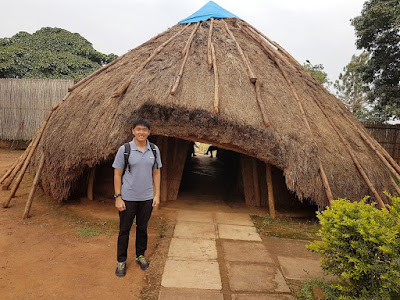Karbabad, Bahrain
Daily: 8.00am - 6.00pm
Known by many international tourists as Bahrain Fort, Qal'at al-Bahrain is an archaeological site inscribed as a UNESCO World Heritage Site. It was once the capital of the Dilmun civilisation that flourished from around the late fourth millennium to 800 BC.
My BFF and I asked a hotel staff to help us get a cab, but the person called a friendly personal driver instead in order for us not to get scammed. We paid BHD 7.000 (~S$24.65) for a one-way trip to the fort. Considering that a taxi ride from the airport to Manama would be around BHD 6.000 (~S$21.15), I thought that was a reasonable price to pay.
 |
| The twin towers of the iconic Bahrain World Trade Centre spotted! |
 |
| Seeing that building somehow reminded me of Wisma 46 in Jakarta, Indonesia. |
The driver dropped us in front of Bahrain Fort Museum. Before we left, he gave us a name card just in case we needed a ride. Anyway, given that our time was tight, we didn't go into the museum. From what I've gathered, it offers free guided tours and is closed on Mondays.
 |
| Are those statues of flies? |
 |
| No one sat at the al fresco sitting area of the café as the wind was quite strong. |
As we didn't go to the museum, we went ahead without audio guides. Just past the museum are some remnants of ancient structures.
 |
| It's said that at the peak of its power, Dilmun controlled the Persian Gulf trading routes. |
 |
| Unfortunately, Dilmun's commercial power started declining due to piracy that went rampant. |
The fort itself is located atop a 17.5 hectare artificial hill, enduring more than 4,000 years of continuous occupation.
 |
| Pretty well-preserved, I must say. |
 |
| Let's go in! |
No one will miss the following notice upon entry, which is free of charge.
 |
| Does that read "Allah"? |
 |
| I believe you'd also get a photo of yourself taken at that spot, right? |
What lies beyond the arches?
 |
| That's a guard post, if I'm not mistaken. |
 |
| Time for some history! |
 |
| Some cool-looking coins~ |
 |
| Tylos was the name used by the Greeks to refer to Bahrain. |
We only saw about eight other people when we were there, so it was easy to take people-free photos.
 |
| We could hardly open our eyes as the wind kept blowing the sand off the ground. |
 |
| I wonder what those seemingly useless structures are there for. |
 |
| The walls of the fort were built with various thicknesses using stone masonry. |
 |
| Watch out your head! |
We encountered a small enclosed structure that's accessible to visitors, but there's nothing inside.
Let's continue our journey towards where the flag stands.
We went down to a small room with a well known as Enki's Well. Enki is a Mesopotamian God of fresh water and wisdom.
 |
| As you might've guessed, it's a reconstructed well. I'm not sure where the original is (was) located. |
And then, up we went.
 |
| How many of you notice the difference between Bahrain's and Qatar's flags? |
 |
| I'd really love to ride a horse again! |
Despite the strong UV rays emitted by the sun, we continued with our exploration.
 |
| I wanted to go up to the tower, but not possible, I guess. |
There's an interesting art installation titled 'Madbasa' by Marie-Francoise Rouy, evoking the significance of the old method of producing date molasses.
 |
| It's known that dates were piled up on parallel channels. |
 |
| The juice of the ripe dates would then be squeezed out by combined effects of heat and pressure. |
The further we walked, the less people we saw.
 |
| Hey, let's take cover from the sun! |
 |
| Is that a carving of a ship? |
Below is a picture of the last room I entered. My guess would be either an ancient toilet or a tomb. What do you think?
Feeling satisfied, we decided to end our exploration without making one whole round. We walked back to the museum to see the beach area.
 |
| Life and Death: a tale of two trees |
From there, we took a long walk to Manama Souq.














































































































Comments
Post a Comment